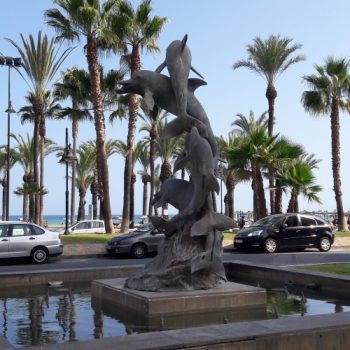
What You Should Know about Burgos
Burgos, Castilla y León
 Transport options to arrive: Train, Bus, Car (or Plane)
Transport options to arrive: Train, Bus, Car (or Plane)
The city is served by an incredibly central bus station that allows for affordable transport from all over Spain, as well as a wide range of foreign cities! It is also reachable by train from Madrid or by plane from a small selection of airports, including Barcelona. As always, having a car allows for optimal mobility (although a car is by no means necessary to see the city).
Recommended time of year to visit and length of visit: Summertime, if you want to avoid the northern cold. While I managed to see everything on my list in just one afternoon, I got such a positive vibe from this city that I would highly recommend spending at least two or three nights to take it in slowly.
 Fun Fact: Burgos is one of the many places that hikers on the Camino de Santiago pilgrimage trek through. For this reason, you are likely to come across seashell signs or symbols that mark the way to Santiago (just about 500km away!). If you get the chance to chat with anyone on this pilgrimage, absolutely find out about their experience―it is a really unique and challenging undertaking which means those who do it tend to be interesting and insightful.
Fun Fact: Burgos is one of the many places that hikers on the Camino de Santiago pilgrimage trek through. For this reason, you are likely to come across seashell signs or symbols that mark the way to Santiago (just about 500km away!). If you get the chance to chat with anyone on this pilgrimage, absolutely find out about their experience―it is a really unique and challenging undertaking which means those who do it tend to be interesting and insightful.
Top three must-sees:
1. La Catedral: This is the most talked about monument in Burgos for a reason! I’ve seen many cathedrals in Spain, but this one still managed to astonish me. Its mere size is impressive, but take into consideration the intricate details carved all around it exemplify the evolution of 1,000+ years of the Gothic style and it’s no one wonder why this building was declared an UNESCO World Heritage Site.
2. El Arco y Puerta de Santa María: Another emblematic site of Burgos is the archway and ‘Door of Santa María.’ Back in the day, the whole city was enclosed inside medieval walls and this entry way was just one of twelve. Nowadays, you can visit the inside of it for FREE and even find an exposition of artwork along its passageway. Afterwards, be sure to stop at a café to enjoy a coffee or sandwich along the Paseo de Espolón, a beautiful, bustling promenade engulfed by some of the most fascinating trees I have ever seen.
3. Paseo de la Isla: Now a part of the mainland, this park area used to be an island between the river and canals of the city. It is considered to be a botanical garden so you can find a wide variety of plants and flora, as well as sculptures, busts, and replicas of historical architecture that just seem to pop up out of nowhere! Definitely an enjoyable, shady place to stroll through on a slow afternoon.
 One thing to eat: Queso de Burgos
One thing to eat: Queso de Burgos
Heavy, meat-and-legumes based dishes are popular in Burgos, but on the lighter side you have Burgo’s cheese. This soft, white cheese (considered queso fresco in Spain) is traditionally made throughout the province of Burgos because of its temperate climate that historically allowed them to keep this cheese fresh without needing to cure it (like most cheeses in Spain, which you can read more about here). I recommend enjoying it with honey (miel) or membrillo (a jelly-like fruit spread), often offered on menus as the postre del abuelo (Grandfather’s dessert―contains nuts).




